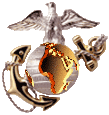

The first two days of July, SLF Alpha on board the ships of TG 76.4, prepared for Operation Bear Claw, a proposed landing in eastern Quang Tn Province. The SLF cancelled Bear Claw at 0100 on the 3rd when it received orders alerting BLT 1 / 3 for ini mediate employment in the 9th Marines TAOR at Con Thien. The 9th Marines was in trouble.
Lieutenant Colonel Richard J. "Spike" Schening's 1st Battalion, 9th Marines provided the security of the Con Thien perimeter. Two of the battalion's companies, A and B, on patrol a mile and a half northeast of Con Thien, had discovered a large NVA force, at least two battalions of the 90th NVA Regiment. The initial contact took place as the Marine companies were trying to link up. In this awkward situation, the North Vietnamese managed to punish each company separately. Additionally, the Communists hit the Marines with massed artillery fire from north of the DMZ. Casualties mounted on both sides as the battle intensified. Company B lost most of its officers; the company commander, his FO, the FAC, and two platoon commanders were casualties.
Responding to this serious situation, Lieutenant Colonel Schening committed Company C, 1st Battalion, 9th Marines, reinforced by tanks. The action intensified as the 3d Battalion, 9th Marines arrived from Dong Ha to help regain control of the situation. At this stage, III MAF requested STY Alpha. Similarly, SLF Bravo, also at sea, went on alert. The mission assigned to SLF Alpha during Operation Buffalo, the name given the continuing engagement with the 90th NVA Regiment, was to tie in to the right flank of the 3d Battalion, 9th Marines and sweep the battle area to recover 1st Battalion, 9th Marines' casualties.
The original 0100 warning order for SLF Alpha preceded a regimental briefing at 0700 which set L-hour at 1030. After much frenzied action on the part of the SLF, the launch took place on schedule. Throughout the late morning of 3 July, Lieutenant Colonel Kapetan's HMM-362 flew BLT 1 / 3 into the zone of action, supplemented by CH-46s from SLF Bravo's HMM-164.1~ Unfortunately, the lead assault elements of the BLT landed 2,500 meters south of the designated landing zone, a mile southeast of Con Thien. Readjusting the battalion cost valuable time. The first physical contact with the right flank of the 3d Battalion 9th Marines occurred at 1315. By the time all of BLT 1 / 3 had moved into the correct positions, however, the level of fighting had waned, and only Communist gunners remained active. The night of 3-4July was relatively quiet, as was the next day. The 5th opened with an early morning enemy mortar attack against Companies A and C. Exchanges of artillery and mortar fire punctuated most of the day. The battalion continued its sweep operation. On the 6th, enemy rockets knocked out a Marine tank. The fighting around the disabled tank became so savage that the BLT did not reach the burnt-out hulk until 1000 on the 7th of July. The Marines recovered the bodies of the crew early the next morning.
At 1330, 8 July, the BLT received orders to make an immediate withdrawal. This was a challenging operation even under ideal circumstances. Wickwire's battalion faced a dangerous situation. There were five complications: it was daylight; the battalion was in contact; the withdrawal would occur over 600 meters of open ground; two of the attached tanks were crippled; and the battalion had just received re-supplies and had no organic transport to move the vital, though cumbersome, material. A sixth factor added to the BLT's problems. Just as the withdrawal began, the Communists opened up with small arms, mortars, and artillery. In spite of these difficulties, the battalion carried out this complex maneuver with only light casualties.
The next four days of Buffalo involved patrolling the Con Thien perimeter. Buffalo ended on the morning of 14 July. The Marines of BLT 1 / 3 had recovered the bodies of 11 fellow Marines from the 1st Battalion, 9th Marines, but their efforts were costly; the BLT's price was eight killed and 179 wounded. Operation Buffalo produced a total of 424 verified North Vietnamese dead for the BLT.
While Buffalo neared its terminal phase, Coin USMACV directed that a followup sweep be con ducted of the area south of the DMZ and east of Con Thien. In response, III MAF initiated Operation Hickory II. The plan called for SLF Alpha's BLT 1 / 3 to move out from its final Buffalo positions with the 1st Battalion, 4th Marines on the BLT's right. The combined force would sweep southward in a search and destroy operation. Three other battalions were to block north and south of the operational area. All Hickory II battalions came under the operational control of the 9th Marines, with the exception of SLF Bravo which served the 3d Marines as a blocking force on the western edge of the sweep zone received orders to move to a phase line approximately 15,000 meters south of its position by 1700 the next day. As a consequence, though the deployed battalion formations remained prepared to engage the enemy, the required speed of advance prevented the battalion from making a detailed search of its zone of action. During Hickory II, BLT 1 / 3 experienced no enemy contact, and the net result was the capture of 17 suspects. There were no friendly casualties. The operation ended at 1600 on 16 July and the next day SLF Alpha returned to the TG 79.4 ships.
ECHO
2/3
Bear Claw/Hickory II
SLF Alpha in Bear Claw/Buffalo/Hickory II
(3-16 July 1967)
Paul Marquis
Web Master
